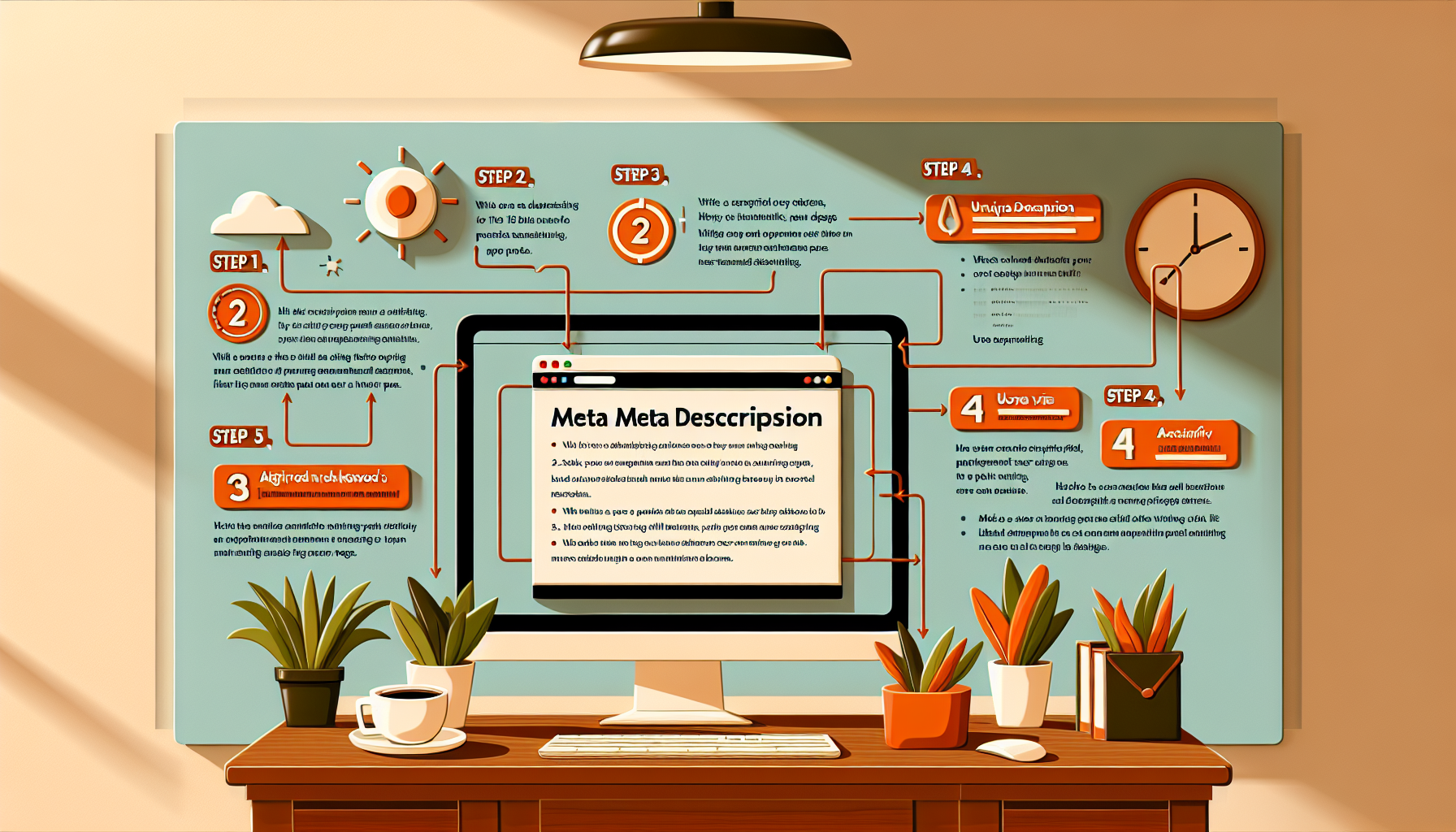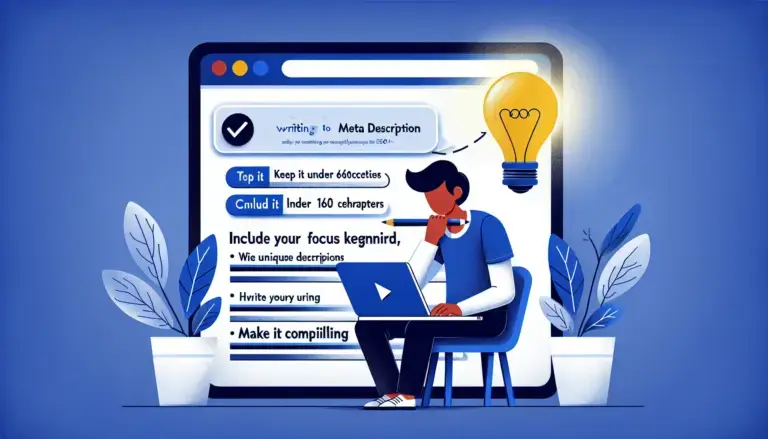A meta description is a brief snippet of text that appears in search engine results under the title of your webpage. Its primary purpose is to provide a concise summary of the content of the page, helping users decide whether or not to click through to your site. It serves as a digital pitch that entices and informs potential visitors, thereby increasing the click-through rate (CTR) of your page.
Search engines like Google use meta descriptions to determine the relevance of a page to a user’s search query. While not a direct ranking factor, a well-crafted meta description can significantly impact the visibility and attractiveness of your link in search results. By effectively conveying the value and essence of your webpage, it can improve user experience and engagement.
Furthermore, meta descriptions also play a crucial role in social sharing. When links to your webpage are shared on social media platforms, the meta description is often displayed, providing an additional opportunity to attract visitors from those channels. Therefore, understanding the purpose of a meta description is essential for both SEO and overall digital marketing efforts.
Key elements of an engaging meta description

An engaging meta description begins with understanding your audience and what will compel them to click. The most captivating ones typically include a few key elements: a clear, concise summary, a touch of emotion, and a call to action (CTA).
The summary needs to be focused on the user’s intent and the primary content of your webpage. This means addressing the question or need that brought the user to the search engine in the first place. Use straightforward language that gets directly to the point.
Including an emotional trigger can also enhance the effectiveness of your meta description. This could involve creating a sense of urgency, curiosity, or addressing a pain point your audience experiences. For example, if your article solves a common problem, you might hint at the solution in an inviting way: “Struggling with stubborn stains? Discover the ultimate guide to spotless laundry.”
The CTA is another crucial element. It subtly invites users to take the next step, such as “Learn more,” “Find out how,” or “Get started today.” A well-placed CTA can increase the user’s desire to click through by clearly indicating what they will gain from visiting your site.
Avoid generic descriptions that could apply to a multitude of pages. Instead, make each meta description unique, aligning it closely with the specific content of the page it describes. This not only provides a better user experience but also signals to search engines that your content is relevant and valuable.
Best practices for meta description length

When crafting your meta description, it’s essential to consider its length. While there is no strict rule, Google typically truncates meta descriptions to around 155-160 characters on desktop and slightly shorter on mobile devices, usually between 120-130 characters. Hence, it’s best to aim for a length that falls within this range to ensure that your message is displayed in full and does not get cut off in search results.
To maximize the effectiveness of your meta description, prioritize including the key information and most compelling details at the beginning. This ensures that even if the description is cut short, the essential elements that attract clicks and engagement remain visible and impactful.
Conciseness is crucial. Avoid fluff and unnecessary words that do not add value to the description. Every word should serve a purpose, contributing either to clarify the page’s content or to persuade the user to click through. This approach not only helps in maintaining the ideal length but also enhances the overall quality and coherence of your meta description.
A practical tip is to draft several variations of your meta description and test them out to see which one best fits within the character limits while still being engaging and informative. Over time, you will gain a sense of what works best for your audience and search engines alike.
Utilizing a tool or plugin that previews how your meta description will appear in search results can also be highly beneficial. This allows you to adjust the length and wording accordingly before finalizing the description, ensuring it is optimized for both desktop and mobile views without requiring constant adjustments post-publishing.
How to incorporate keywords naturally

Incorporating keywords into your meta description is essential for SEO, but it must be done naturally to avoid coming across as forced or spammy. Start by conducting thorough keyword research to identify the phrases and terms that your target audience is likely to use when searching for content related to your page. Focus on primary and secondary keywords that are relevant to your content.
Once you have your keywords, the next step is to integrate them smoothly into your meta description. Begin with the most relevant keyword, preferably placing it near the start of the description. This not only captures the attention of users quickly but also signals to search engines what the page content is about. For example, if your target keyword is “easy home workout routines,” your meta description could start with, “Discover easy home workout routines that fit into any busy schedule.”
Avoid keyword stuffing, which means cramming as many keywords as possible into your meta description. This practice can make the description awkward and less engaging, reducing the likelihood of clicks. Instead, aim for a natural flow of words where the keyword fits seamlessly within the overall context. Think of the meta description as a brief conversation with the user, where you are explaining the content of the page in a friendly and persuasive manner.
Consider using variations or synonyms of your main keyword to maintain a natural tone. For instance, if your primary keyword is “best travel tips,” you could use related phrases like “top travel advice” or “essential travel hacks” within the same description. This approach not only helps in avoiding repetition but also broadens the scope of keyword relevance, enhancing search engine optimization.
Don’t forget to match your meta description to the actual content on your page. Misleading descriptions that don’t align with the page content can lead to a higher bounce rate, as users quickly leave the site once they realize it doesn’t meet their expectations. Consistency between your meta description and page content ensures a positive user experience and builds trust with your audience.
Add an action-oriented element to make your description more compelling while naturally including your keywords. Phrasing like “Learn the best travel tips for your next adventure” or “Explore easy home workout routines to stay fit” not only incorporates keywords but also encourages users to click through because of the clear benefit they will receive.
Common mistakes to avoid in meta descriptions

One common mistake is failing to make the meta description unique for each page on your website. Using the same meta description for multiple pages can confuse search engines and diminish the value of your content. Each page should have its own tailored meta description that accurately reflects its unique content and key points. This approach not only enhances SEO but also improves user experience by providing relevant information about each specific page.
Another mistake to avoid is writing meta descriptions that are too long or too short. If your meta description exceeds the recommended character limit (155-160 characters for desktop and 120-130 characters for mobile), search engines will truncate it, potentially cutting off important information. On the other hand, a meta description that is too short might not provide enough information to compel users to click. Striking the right balance in length is crucial for maintaining clarity and appeal.
Overlooking the importance of a compelling call to action (CTA) is a mistake that can significantly reduce the effectiveness of a meta description. A strong CTA guides the user towards the desired action, increasing the likelihood of a click-through. Phrases like “Learn more,” “Discover how,” or “Get started today” provide clear guidance and add a sense of urgency, making your meta description more engaging and action-oriented.
Avoiding the use of relevant keywords is another common oversight. While keyword stuffing is detrimental, completely neglecting to include keywords can cause your meta description to miss the mark in terms of SEO. It’s critical to use relevant keywords naturally within your description to help search engines understand the content of your page and to attract users who are searching for those terms. Proper keyword integration can significantly improve your page’s visibility in search engine results.
Neglecting to address the user’s search intent can lead to a poorly crafted meta description. The description should resonate with the searcher’s needs and motivations. If your meta description fails to address the user’s intent or the question they are looking to answer, it is less likely to draw them in. Understanding and aligning with the search intent ensures that your meta description is relevant and appealing to your target audience.
Lastly, failing to conduct A/B testing on your meta descriptions can result in missed opportunities for optimization. Testing various versions of your meta descriptions to see which ones perform best can provide valuable insights. Different phrasings, keyword placements, and CTAs can have varying impacts on user behavior. Regular testing allows you to refine your approach based on real data, ensuring that your meta descriptions are always optimized for maximum effectiveness.

